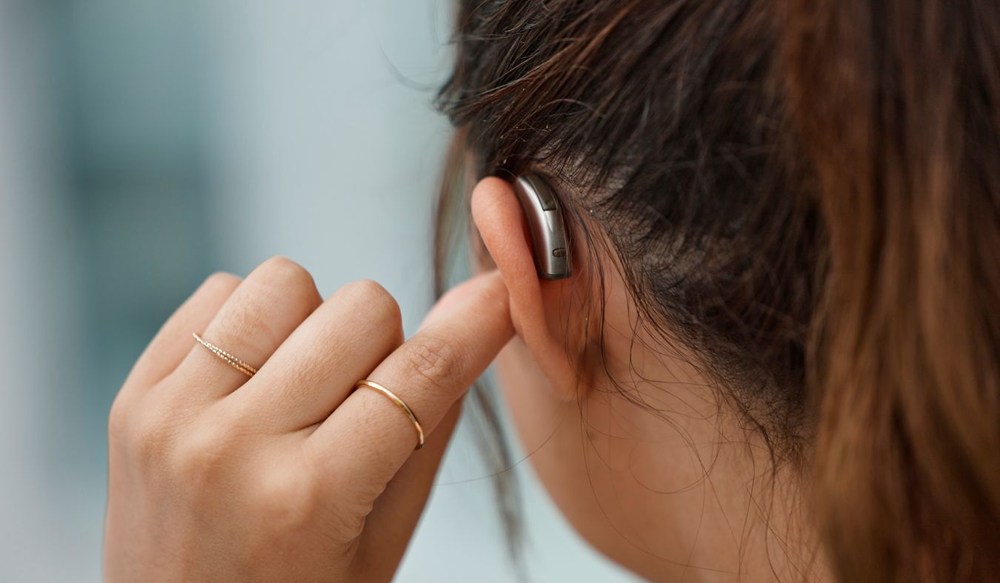The Impact of 5G on Hearing Aid Technology
As 5G wireless networks continue to expand, they are influencing how we
Call (844) 958-5304 to schedule today!

By: admin | August 21, 2025
Your hearing needs change dramatically throughout a typical day. The settings that work perfectly for a quiet conversation at home might leave you struggling to follow along in a busy restaurant or during a work presentation. You need to hear clearly whether you’re in your car with road noise, at a family gathering with multiple conversations happening or trying to focus on a phone call in a noisy office. One-size-fits-all approaches to hearing aids often fall short because real life involves constantly shifting between different acoustic environments.
Modern hearing aids have gotten much better at recognizing these changes and adapting automatically. Instead of manually adjusting settings every time you move from one place to another, today’s devices can sense what kind of environment you’re in and modify their performance accordingly. This means you can move from a quiet coffee shop to a crowded mall without constantly fiddling with controls or worrying about whether you’ll be able to hear properly.
Understanding how your hearing aid works can make it easier to use and care for it each day. While there are different styles of hearing aids, most of them share the same basic components. These include a microphone, an amplifier, a speaker (also called a receiver), a battery or rechargeable power source, and often a few built-in controls or buttons. The microphone picks up sounds from the environment and sends them to the amplifier, which makes the sound louder and clearer. That sound is then delivered into your ear through the receiver.
Many hearing aids also include digital processing chips. These tiny processors analyze incoming sound and automatically adjust settings in real time to match your environment. For example, they might reduce background noise in a crowded room or make quiet speech easier to hear during a conversation. Some hearing aids also offer directional microphones, which help focus on sound coming from in front of you while minimizing distractions from the sides or behind.
The way hearing aids improve your hearing depends on how they are programmed. Your hearing specialist uses the results from your hearing test to adjust the settings so that the device matches your specific hearing needs. Softer sounds are amplified more than loud ones, and certain frequencies may be boosted depending on the type of hearing loss you have. The goal is to make speech and important environmental sounds easier to understand without overwhelming you with unnecessary noise.
Knowing what each part does also makes it easier to recognize if something is not working the way it should. With proper care and the right settings, hearing aids can make a big difference in how clearly you hear and how comfortably you participate in everyday situations.
Where you are and what is happening around you can make a big difference in how your hearing aids perform. Most modern hearing aids are designed to adjust automatically based on your surroundings, but understanding how different environments affect sound can help you get the best results. For example, a quiet living room with soft background noise is very different from a noisy restaurant filled with overlapping conversations, clinking dishes and music. Each of these settings places different demands on your hearing aids.
In quiet environments, hearing aids focus on amplifying softer sounds like speech or subtle background noises, helping you stay engaged in one-on-one conversations. In contrast, noisy or crowded places require your devices to work harder to separate speech from background noise. Many hearing aids include features like directional microphones and noise reduction to help manage these situations. These features prioritize sounds coming from the front while minimizing distractions from the sides or behind you.
Outdoor settings can also influence how your hearing aids perform. Wind, traffic or distant conversations can all create challenges. Some hearing aids include wind reduction settings or environmental detection features that automatically adjust to reduce interference. Even room acoustics, like echoes or the way sound bounces off hard surfaces, can affect how clearly you hear. Understanding how your devices respond in different settings helps you know what to expect and when small adjustments might be needed.
Quiet indoor spaces can have a noticeable impact on how your hearing aids perform. Environments like your living room or a small office tend to have less background noise, which allows your hearing aids to focus more precisely on speech and softer sounds. In these settings, you may find it easier to follow conversations without the interference of competing noise. Because there is less for the hearing aid to filter out, the overall listening experience often feels clearer and more comfortable.
Quiet rooms can also bring out sounds you might not have noticed before. The low hum of a refrigerator, the soft buzz of a light fixture or the subtle rustle of clothing can seem more pronounced when there is nothing else competing for your attention. These background sounds are not harmful, but they can be distracting until you adjust to how your hearing aids process them. Your brain will usually adapt over time, learning which sounds to focus on and which to tune out.
Room acoustics also play a role. Smaller spaces with soft furnishings absorb sound and make speech easier to understand. In contrast, rooms with bare walls, tile floors or high ceilings can create echoes or make voices sound slightly hollow. These changes in sound quality are normal and do not mean your hearing aids are malfunctioning.
Noisier environments create more challenges for hearing aids. Places like restaurants, busy offices or crowded family gatherings often include layers of sound coming from multiple directions. These overlapping voices, background music and other activity can make it harder for your hearing aids to focus on the person you are trying to hear. While many hearing aids include features like directional microphones and background noise reduction, there are limits to how well they can separate speech from everything else happening around you.
In these situations, your hearing aids work to prioritize sounds coming from directly in front of you while lowering the volume of noise coming from the sides or behind. This helps improve focus during one-on-one conversations but does not completely block out all background sound. In fact, trying to completely eliminate environmental noise would create an unnatural listening experience. The goal is to strike a balance, where important sounds stand out without making everything else disappear.
It is also common for the acoustics in busy places to affect how your hearing aids perform. Hard surfaces, high ceilings and open layouts can cause sound to bounce and overlap, making speech harder to isolate. Your brain needs time to adjust in these situations, especially if you have recently started using hearing aids.
Heading outside with your hearing aids can be an invigorating experience. The sounds of nature, city streets or even a bustling market are all within your reach. However, outdoor environments can also present unique challenges for your hearing aids.
The key to a successful outdoor experience with your hearing aids lies in understanding and adjusting to these challenges. For instance, wind noise can sometimes interfere with the effectiveness of your hearing aids. To counter this, many modern devices come equipped with wind noise reduction features. Similarly, understanding how to adjust volume levels and other settings for different outdoor situations can greatly enhance your overall listening experience. With a bit of knowledge and practice, you can confidently navigate any outdoor environment with your reliable hearing aids.
Outdoor settings bring unique challenges for hearing aids. Unlike indoor spaces, outdoor environments often include shifting sounds like traffic, wind, birds and distant conversations. Your hearing aids adjust automatically to these changes, but the mix of natural and manmade sounds can affect how clearly you hear and how comfortable the experience feels.
Wind is one of the most noticeable issues outside. When air moves across the microphone, it can create a loud rushing sound that covers up speech or softer noises. Many hearing aids include wind reduction features, but strong gusts can still interfere. Wearing a hat or facing away from the wind can help reduce this effect.
Moisture is also important to keep in mind. Rain, sweat or high humidity can impact performance even in water-resistant models. Wiping your hearing aids down after time outside and storing them properly at night helps protect them. Being aware of how outdoor elements affect your devices makes it easier to plan ahead and stay comfortable wherever you go.
Today’s hearing aids come with a wide range of advanced features that can make listening easier and more comfortable. Many models adjust automatically based on your surroundings, helping you move from quiet rooms to noisy spaces without needing to press any buttons. These automatic settings can fine-tune volume, reduce background noise and focus on speech, all in real time.
Some hearing aids include Bluetooth, which allows you to stream audio directly from your phone, tablet or television. This can improve clarity for phone calls or media and reduce the strain of trying to hear through external speakers. Many devices also work with smartphone apps that let you adjust settings, switch programs or even track battery life right from your screen. These tools give you more control and help you fine-tune your hearing experience throughout the day.
Other helpful features include directional microphones, feedback reduction and rechargeable batteries. Directional microphones focus on the sounds in front of you and minimize distractions from behind or beside you. Feedback reduction helps prevent high-pitched whistling, and rechargeable models remove the need to handle small batteries. If you are unsure which features apply to your device, your hearing specialist can walk you through what is available and how to use it.
When getting used to hearing aids, asking the right questions can make a big difference in how well they work for you. A good place to start is by asking how your hearing aids are set up for different environments. You might want to know how they handle background noise in busy places or whether they automatically adjust between quiet and loud settings. Understanding what your devices are designed to do helps you use them more confidently in daily life.
It is also worth asking about specific features built into your hearing aids. For example, do they include Bluetooth streaming, and if so, how do you connect them to your phone or TV? Can you adjust volume or settings on your own, or is that handled through an app? Your hearing specialist can walk you through these options and help you learn how to take advantage of them without feeling overwhelmed.
If you are unsure whether a certain feature is right for your needs, do not hesitate to ask about that too. Your professional can explain the benefits and help you decide what is useful based on your routine, your most common listening environments and your comfort with technology. The more questions you ask, the better your devices can be tailored to fit your lifestyle.
Being able to move through your day without stopping to adjust your hearing aids every few minutes is a relief, especially when your surroundings are always changing. The right devices can take care of those shifts for you, helping you stay focused on conversations and comfortable in different spaces. Whether you’re out running errands or catching up with a friend in a noisy café, your hearing aids should work with you, not against you.
If you’re ready to find hearing support that keeps up with your daily routine, we’re here to help. Contact At Home Hearing Healthcare in Pembroke, MA at (844) 958-5304 to learn more about hearing aids that adjust to your lifestyle and simplify the way you hear throughout the day.
Tags: benefits of hearing aids, hearing aid repair, hearing aid styles

As 5G wireless networks continue to expand, they are influencing how we
By: admin | December 21, 2025

Your hearing needs change dramatically throughout a typical day. The
By: admin | August 21, 2025

Travel disrupts your normal routines in many ways, from changing your
By: admin | April 24, 2025
